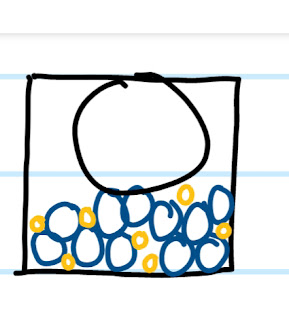I'm going to say something that I hope no one disagrees with - the goal of explaining something is to enable students to understand that particular concept. The understanding of said concept can, of course, be used as a foundation to build further understanding.
I think there is a temptation to put too much into our explanations. We want them to be perfect, accurate representations of the science. But that misses the point. We are explaining things to children. To novices. They don't need perfect representations just yet - a simplified model is good enough. Now, I'm not saying it's fine to allow misconceptions to embed, but what I am saying is that we need to start simple. Explain it in its plain sense. Then add the extras as students progress.
An example: I want students to be able to identify mixtures, and to give a definition of a mixture. I don't care about compounds, or pure substances, or anything else. Just mixtures. As part of my explanation, I built up this diagram, talking about how the sugar [yellow circles] doesn't really attach itself to the water [blue circles], how they're still separate substances, they haven't what we call "bonded" together.
It could be argued that I missed an opportunity to explain dissolving. How exactly do those "sugar particles" fit into the gaps between the "water particles"? But does that add anything to the explanation of what a mixture is? Does it help a student to identify a mixture? No. Yes, it's true/more accurate/more perfect science/whatever. Yes, it's useful further down the line. But we're not further down the line. Right now, all that will happen is my explanation gets bloated and the students get lost and wait are we talking about dissolving or mixtures and if something isn't dissolved then it's not a mixture or hang on was it it's only a mixture if it is dissolved ugh science is hard.
I like to think in terms of a sliding scale. At one end, we have the stuff that is absolutely vital to the explanation. At the other end we have the stuff that is harmful. And everything else falls in the middle somewhere. Where it falls will depend on the class, their prior knowledge, their engagement, etc etc. It's not an exact science.
- Vital: This is the content that without it, students will not be able to understand what you are explaining. It's the definitions, it's the nitty-gritty, the specifics. The foundations. If you remove this stuff, the explanation will fall apart. The meat-and-potatoes, if you will.
- Important: This is the details that centre the explanation in a narrative. This is where we find the hinterland. Without it, the explanation will still make sense - it's not going to become meaningless like it will if we miss out the vital stuff - but it will be harder to understand. Maybe it won't flow so well, or it will be missing the "hook", or maybe the kids just won't care. I find this is the stuff that we add to our lessons. The vital bits are the stuff you find in a textbook, but the important bits are the flavour we season our lessons with.
- Distracting: This is where I'd put the explanation of dissolving I referenced earlier. It's not helping students to understand mixtures. It's directing their attention away from what you want them to think about. If you have a super high attaining class, then going off on these tangents probably won't be a massive issue, but if you've got bottom set year 9, it's better to avoid them. [This is also where I'd put animations, btw]. I'm going to milk my terrible analogy for all it's worth and say this is the giant bowl of flowers in the middle of the table. It's not technically preventing anyone from eating their dinner, but they do keep dipping into the gravy and it would be a much better experience if they weren't there.
- Harmful: All models are wrong. But if your model helps to reinforce a misconception, why are you using it? This stuff is the fly in the soup. The broken chair. The cracked bowl. If these things are in your explanation, your students are not going to be able to understand what you're on about.
NB: ignoring for now, and reinforcing are not the same thing. It's often useful to get to the end of the explanation before addressing the misconception, rather than breaking the narrative to address it.
I think there can be very much a temptation to go beyond the important when explaining something, just because it's right/true/more accurate/better science. But we don't need to all the time. If doing so will result in poorly-built foundations, leave it. We don't have to build the whole house now.

